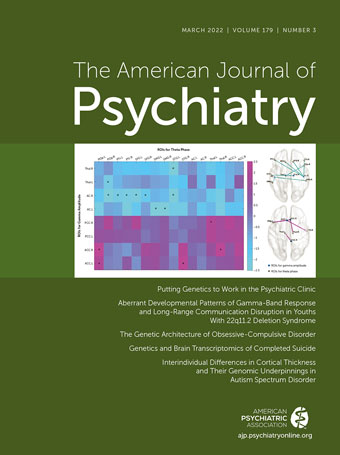Genes To Mental Health (G2MH): A Framework to Map the Combined Effects of Rare and Common Variants on Dimensions of Cognition and Psychopathology
Abstract
BOX 1. Definitions relevant to genetics and neurodevelopmental disorders
| Chromosome Coordinates (Genes) | Start and Stop (Mb) (from hg19) | Effect Size for IQb | Frequency of Intellectual Disability (%) | Odds Ratio for Autism Spectrum Disorderc | Odds Ratio for Schizophreniac |
|---|---|---|---|---|---|
| 1q21.1 deletion (CHD1L) | 146.53–147.39 | –15.15d | 16.1 | 3.2e | 6.4f |
| 1q21.1 duplication (CHD1L) | 146.53–147.39 | –25.35d | 37.8 | 5.3e | 2.9g |
| NRXN1 deletion | 50.14–51.26 | –9.0 | 8.1 | 7.9e | 4.7h |
| 3q29 deletion (DLG1) | 195.73–197.34 | –31.5 | 54.0 | 19.0e | 23.0h |
| 7q11.23 duplication (ELN) | 72.7–74.1 | –13.95 | 14.2 | 32.0e | 16.1h |
| 15q11.2 deletion (CYFIP1) | 22.81–23.09 | –5.7 | 5.3 | 1.3i | 1.9i |
| 15q13.3, BP4-BP5 deletion (CHRNA7) | 30.92–32.51 | –21.9 | 29.5 | 15.0e | 18.0h |
| 16p13.11 deletion (MYH11) | 15.51–16.29 | –7.35 | 6.5 | 2.5e | 2.2f |
| 16p13.11 duplication (MYH11) | 15.51–16.29 | –8.7 | 7.8 | — | 1.5g |
| 16p11.2 distal deletion (SH2B1) | 28.82–29.05 | –9.15 | 8.2 | 3.6e | 4.4h |
| 16p11.2 distal duplication (SH2B1) | 28.82–29.05 | –3.0 | 3.6 | — | 1.3f |
| 16p11.2 deletion (MAPK3) | 29.65–30.2 | –26.0j | 39.4 | 14.3e | 1.1f |
| 16p11.2 duplication (MAPK3) | 29.65–30.2 | –11.0j | 10.2 | 10.5e | 11.7h |
| 17p11.2 duplication (RAI1) | 17–21.4 | –49.2 | 90.0 | 32.0e | 11.3f |
| 17q12 deletion (HNF1B) | 34.81–36.22 | –11.55 | 11.0 | 3.5k | 6.6g |
| 17q12 duplication (HNF1B) | 34.81–36.22 | –6.6 | 6.0 | — | 1.9f |
| 22q11.2 deletion (TBX1) | 19.04–21.47 | –28.5 | 46.0 | 32.3e | 23.0l |
| 22q11.2 duplication (TBX1) | 19.04–21.47 | –13.65 | 13.8 | 2.0e | 0.2h |
DO RARE VARIANTS EXERT SPECIFIC OR SHARED EFFECTS ON PSYCHOPATHOLOGY?

PHENOTYPIC VARIABILITY

KNOWLEDGE GAPS
An Elusive Phenome: Closing the Gap Between the Tidal Wave of Gene Discovery and Phenotypes
Biases and Challenges in the Field
Ascertainment methods.
Cultural biases.
Subjective methods of assessments—diagnostic criteria.
PRECISION PSYCHIATRY: TRANSLATING KNOWLEDGE INTO THE CLINICAL SETTING
Predictive Testing

Preventive Care and Interventions
Lack of Routine Genetic Testing in Psychiatric Clinics
BOX 2. Clinical vignettes
G2MH ROADMAP
New Data Collection
Leveraging Archival Data
Phenotypic Harmonization Strategy
New Satellite Projects
Data Sharing
CONCLUSIONS
Footnotes
Supplementary Material
- Download
- 15.28 KB
References
Information & Authors
Information
Published In
History
Keywords
Authors
Funding Information
Metrics & Citations
Metrics
Citations
Export Citations
If you have the appropriate software installed, you can download article citation data to the citation manager of your choice. Simply select your manager software from the list below and click Download.
For more information or tips please see 'Downloading to a citation manager' in the Help menu.
View Options
View options
PDF/EPUB
View PDF/EPUBLogin options
Already a subscriber? Access your subscription through your login credentials or your institution for full access to this article.
Personal login Institutional Login Open Athens loginNot a subscriber?
PsychiatryOnline subscription options offer access to the DSM-5-TR® library, books, journals, CME, and patient resources. This all-in-one virtual library provides psychiatrists and mental health professionals with key resources for diagnosis, treatment, research, and professional development.
Need more help? PsychiatryOnline Customer Service may be reached by emailing [email protected] or by calling 800-368-5777 (in the U.S.) or 703-907-7322 (outside the U.S.).

